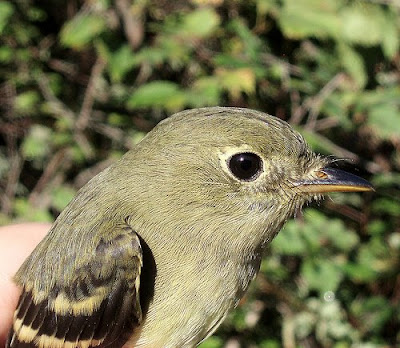 This is likely the brightest young male Blackburnian Warbler I've ever banded in the fall. Usually they stay pretty high in the trees so I don't catch many of them. They are always a treat.
This is likely the brightest young male Blackburnian Warbler I've ever banded in the fall. Usually they stay pretty high in the trees so I don't catch many of them. They are always a treat.
Last week I was catching female Black-throated Blue Warblers, but this week I had a few males. Beautiful!
 I expect to see Philadelphia Vireos between 15 and 25 September...they are pretty prompt and have a tight migration window. I just couldn't capture how fresh and bright the yellow on this bird was, but it was a beauty.
I expect to see Philadelphia Vireos between 15 and 25 September...they are pretty prompt and have a tight migration window. I just couldn't capture how fresh and bright the yellow on this bird was, but it was a beauty.
I like the fiesty personality of vireos, and my favorite species is Blue-headed Vireo. I don't catch many of them either, so I was happy to see this one. Isn't it gorgeous?
Another infrequently banded species is Eastern Phoebe. This photo doesn't show the nice, subtle yellowish color of the breast. The picture also makes it look a little more rotund than usual. They say the camera always adds a few pounds...
I banded our second Connecticut Warbler of the fall, today, too, but the photos are still in the camera.
On Sunday, September 28, the Detroit Audubon Society is having a field trip here, and it's open to the public. It will include short walks on the trails, and a look at birds in the hand, should we have some to show. I'll be available to answer all your burning questions. This program is weather permitting: we'll not be banding if it is windy or raining, or threatening rain. Meet on the south patio of the Environmental Interpretive Center (EIC) at 8 AM. Directions to campus and a campus map are linked about halfway down this page on the RRBO web site.












